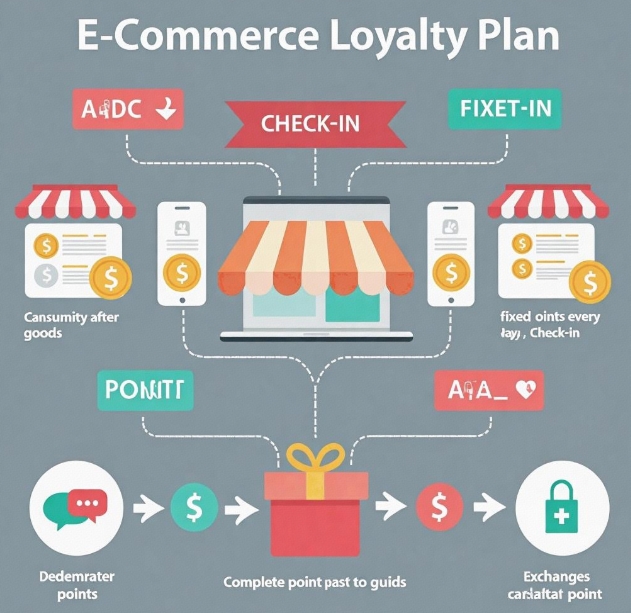Core Mechanisms of the Points Mall: Analysis of Points Earning and Redemption Rules
- latest articles
- 1.DApp Development & Customization: Merging Diverse Market Needs with User Experience 2.Analysis of the Core Technical System in DApp Project Development 3.How to achieve cross-chain interoperability in Web3 projects? 4.How does the tokenization of points reconstruct the e-commerce ecosystem? 5.How to Set and Track Data Metrics for a Points Mall? 6.What is DApp Development? Core Concepts and Technical Analysis 7.Inventory of commonly used Web3 development tools and usage tips 8.Development of a Distribution System Integrated with Social E-commerce 9.Six Key Steps for Businesses to Build a Points Mall System 10.What is DApp Development? A Comprehensive Guide from Concept to Implementation
- Popular Articles
- 1.Future Trends and Technology Predictions for APP Development in 2025 2.Analysis of the DeFi Ecosystem: How Developers Can Participate in Decentralized Finance Innovation 3.From Zero to One: How PI Mall Revolutionizes the Traditional E-commerce Model 4.DAPP Development | Best Practices for Professional Customization and Rapid Launch 5.Recommended by the Web3 developer community: the most noteworthy forums and resources 6.From Cloud Computing to Computing Power Leasing: Building a Flexible and Scalable Computing Resource Platform 7.How to Develop a Successful Douyin Mini Program: Technical Architecture and Best Practices 8.Shared Bike System APP: The Convenient Choice in the Era of Smart Travel 9.How to Create a Successful Dating App: From Needs Analysis to User Experience Design 10.From Design to Development: The Complete Process of Bringing an APP Idea to Life
With the rapid development of e-commerce and online finance, points malls have become a crucial link for interaction between many merchants and consumers. Whether it's large e-commerce platforms or traditional retail brands, they have started using points malls to enhance customer loyalty, promote consumption, and increase brand allegiance. A points mall is not merely a simple reward mechanism; it conceals complex and sophisticated business strategies behind it. This article will delve into the core mechanisms of points malls, particularly the rules for earning and redeeming points, and explore how they effectively facilitate a two-way value exchange between merchants and consumers.
I. Definition and Development Background of Points Malls
A points mall, as the name suggests, is a reward platform based on points. Consumers earn points by making purchases, checking in, participating in activities, etc., on the merchant's platform and can use these points to redeem goods or services. This model first appeared in the loyalty programs of airlines and hotels and later gradually spread to various industries. Especially on e-commerce platforms, the application of points malls has become increasingly widespread, serving as an important tool for merchants to maintain relationships with customers.
From the initial "purchase rewards" to today's "social interaction" and "personalized recommendations," the development of points malls has moved beyond traditional point accumulation and redemption. Modern points malls often integrate technologies such as big data analytics, artificial intelligence, and personalized recommendations, making them a vital channel for merchants to gather user data and gain insights into consumer needs.
II. Analysis of Points Earning Mechanisms
Points earning is one of the most fundamental and important aspects of a points mall. It determines what consumer behaviors can earn points and the quantity and weight of points associated with each action. Common ways to earn points include:
1. Purchase Points
The most traditional way to earn points is by purchasing goods or services in the mall, where points are awarded based on the amount spent or the category of goods. For example, a user shopping on an e-commerce platform and spending 100 yuan might receive 100 points. The exchange rate between points and spending can be flexibly adjusted according to the merchant's strategy.
In this process, merchants typically set an exchange rate (e.g., 1 yuan equals 10 points, 1 point equals 0.1 yuan). This not only encourages consumers to make more purchases but also incentivizes them to engage with the platform over the long term.
2. Check-in and Task Points
To increase user activity and engagement, many platforms implement check-in and task mechanisms to encourage users to visit the platform daily or regularly. For instance, users can earn a certain number of points for daily check-ins; completing specific tasks (such as inviting friends, sharing products, leaving reviews, etc.) also accumulates points. This approach enhances user participation and platform activity.
3. Promotional Event Points
Merchants often attract user participation through various promotional events and distribute points accordingly. For example, during major sales events like "Double 11," consumers can earn extra points when purchasing designated items. Additionally, merchants can stimulate purchase desire through limited-time tasks, point multipliers, and other activities.
4. Social Points
Some platforms promote point earning through social interaction mechanisms. For example, users can earn a certain number of points by referring friends to register or sharing products on social media. This social approach to earning points not only boosts user activity but also effectively promotes user growth for the platform.
5. Membership Tiers and Points Earning
Another earning mechanism in points malls involves differentiating user levels through a membership system. Typically, the higher a user's membership tier, the more generous the points rewards. This design encourages users to increase their spending and participation, enhancing platform loyalty and long-term value. For example, VIP members on a platform might enjoy double points on purchases or even receive exclusive promotional event points.
III. Analysis of Points Redemption Mechanisms
Points redemption is another core mechanism of points malls, directly determining the appeal and commercial value of the points system. In practice, redemption rules are often complex, with merchants designing various redemption methods and rules based on different needs. Common forms of points redemption include:
1. Product Redemption
Product redemption is the most common way to use points. Consumers use their points to redeem goods or services offered by the platform. These items can be the platform's own products or those from partner merchants. Points malls usually set different redemption thresholds to encourage increased spending. For example, 1,000 points might redeem a bottle of shampoo, while 5,000 points could redeem a smartwatch.
The advantage of this redemption method is its directness; consumers can obtain tangible items through their spending, which has high appeal and engagement. Merchants, in turn, can use the points mall to accelerate inventory turnover and reduce storage costs.
2. Cash Voucher and Discount Coupon Redemption
In addition to physical goods, points malls can offer cash vouchers or discount coupons as redemption options. For example, 1,000 points might redeem a 50-yuan shopping voucher, or using 1,000 points could grant a 10% shopping discount. This way, consumers enjoy actual economic benefits while continuing to spend during the redemption process, boosting platform activity.
3. Service Redemption
With changing market demands, more points malls are starting to offer service-based products as redemption options. For instance, consumers can use points to redeem membership services, VIP customer support, movie tickets, travel coupons, etc., on the platform. Service redemption often offers more flexibility and appeal than product redemption, especially in the context of internet consumption upgrades, gradually becoming a mainstream form in many points malls.
4. Cross-Platform Redemption
In some large points mall systems, points can be used not only within a single platform but also redeemed across different platforms. Through partnerships with other platforms, merchants can expand the scope of point usage, allowing consumers to use their points in more scenarios. This approach not only increases consumers' desire to redeem but also strengthens strategic cooperation between different platforms.
5. Points Auctions and Bidding
Points auctions are a relatively novel redemption method where consumers can use points to bid on items. This approach combines point usage with entertainment and competitiveness, enhancing consumer engagement and purchase desire. Especially for limited-edition items and new product launches, points auctions serve as an innovative tool for merchants to attract consumers.
IV. Optimization Strategies for Points Malls
Although points malls provide a win-win platform for merchants and consumers, in practice, merchants and platform operators often face many challenges. To ensure that points malls deliver maximum commercial benefits, merchants should consider the following optimization strategies:
1. Rational Design of Points Earning and Redemption Rules
The design of points earning and redemption rules is crucial. Merchants need to set reasonable earning and redemption rates based on consumer needs, spending behaviors, and market conditions. Overly complex rules may confuse consumers and harm the user experience, while overly simple rules may make the points system unattractive. Therefore, merchants should design a balanced points mechanism that incentivizes active participation while ensuring the proper flow of points.
2. Regular Updates of Products and Services
To maintain the appeal of the points mall, merchants need to regularly update products and services, launching limited-time promotions and exclusive offers. This not only attracts new users but also encourages repeat purchases from existing users, preventing points from lying idle or expiring.
3. Refined Data Analysis and Personalized Recommendations
Leveraging big data analytics, merchants can gain precise insights into consumer shopping preferences and points usage habits, enabling them to launch personalized redemption activities. For example, based on a user's purchase history, merchants can recommend the most appealing products and services, increasing redemption conversion rates.
4. Cross-Platform Collaboration and Integration
As the internet ecosystem continues to integrate, merchants can collaborate with other platforms to achieve points interoperability and sharing. This not only increases consumer participation but also enhances brand exposure and market competitiveness.
V. Conclusion
As an innovative business model, points malls have been widely adopted across various industries, building a bridge of communication between merchants and consumers. Through reasonable points earning and redemption rules, merchants can not only increase purchase frequency but also effectively enhance brand loyalty. However, to stand out in a competitive market, merchants must continuously optimize their points mechanisms and explore more innovative applications to meet consumers' increasingly diverse needs.
-

How does the tokenization of points reconstruct the e-commerce ecosystem?
With the continuous advancement of internet technology and the gradual prolifera···
-

How to Set and Track Data Metrics for a Points Mall?
With the rapid development of the e-commerce industry, points malls, as a common···
-

Development of a Distribution System Integrated with Social E-commerce
With the rapid development of internet technology, the e-commerce industry has e···

 Blockchain
Blockchain












